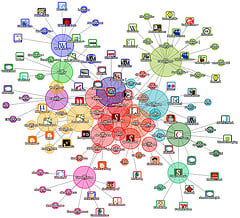
Workshops and articles about Personal Learning Environments (PLEs) or Personal Learning Networks (PLNs) are showing up frequently at conferences and blog postings. Wikipedia dates the first use of the term to November 4, 2004 – an eternity in computer years! I am working up a Lunch and Learn session in two weeks on PLEs, so it is interesting that a number of perspectives surfaced this week…which illustrates that the concept may be over three years old, but it is still evolving.
Earlier this week, David Warlick gave a good synopsis of PLEs by stating that PLEs have “three basic components.
- The network — People who have things to say that help me do my job, and dynamic information sources that provide me with the raw materials I need.
- The tools — Essentially, the avenues of communication through which I connect with people and information sources — conduits that often add value to the information.
- My Own Personal Echo Chamber — This is my own world view from which I teach, where ideas from my PLN bounce around off the walls of my mind and off of other ideas, either losing momentum and fading away, or generating energy and growing.”
David also noted that a fourth component – a zipper – was needed to disengage oneself and stop and smell the roses! Amen, brother!
Kim Cofino discussed the steps educators need to take to be 21st Century educators, which align nicely with David’s points…and also highlight that the wired world is not that simplistic. She saw the need to join social networks (a combination of network and tools such as Ning sites or twitter), the need to use Web 2.0 apps such as Google Reader and iTunes U. (more tools/communications with networked bloggers), the need to blog (which for me is both a personal echo chamber and a communication tool with my network), the need to attend conferences (F2F or virtual), and the need to develop personal connections. This past year has shown me just how tools such as delicious, Skype, blogging, and Twitter develop and reinforce personal connections.

.
You really cannot name three or four components without showing the interconnections between them. I still like D’Arcy Norman’s illustration which when reduced down to thumbnail size simply shows the complexity of the interactions, This may be why David felt compelled to pull out Inspiration and draw a picture of his PLE.
Jeff Utecht had an insightful piece on the stages of adoption he went through with his PLE/PLN:
“Stages of Personal Learning Networks Adoption
Stage 1 Immersion: Immerse yourself into networks. Create any and all networks you can find where there are people and ideas to connect to. Collaboration and connections take off.
Stage 2 Evaluation: Evaluate your networks and start to focus in on which networks you really want to focus your time on. You begin feeling a sense of urgency and try to figure out a way to “Know it all.”
Stage 3 Know it all: Find that you are spending many hours trying to learn everything you can. Realize there is much you do not know and feel like you can’t disconnect. This usually comes with spending every waking minutes trying to be connected to the point that you give up sleep and contact with others around you to be connected to your networks of knowledge.
Stage 4 Perspective: Start to put your life into perspective. Usually comes when you are forced to leave the network for awhile and spend time with family and friends who are not connected (a vacation to a hotel that does not offer a wireless connection, or visiting friends or family who do not have an Internet connection).
Stage 5 Balance: Try and find that balance between learning and living. Understanding that you can not know it all, and begin to understand that you can rely on your network to learn and store knowledge for you. A sense of calm begins as you understand that you can learn when you need to learn and you do not need to know it all right now.”
Michele Martin looked at Jeff’s stages and basically agreed, though she noted that she would have reversed 2 and 3. I am with Michele – I think I went quickly from Immersion to what I would call “Trying to Know It All”. I had a good support group working with me to keep me from being overwhelmed and helping me into the third phase of evaluation. A lesson from this is that while PLE’s are intensely personal, they are best developed collaboratively. In other words, David’s lead off of “network” is vital.
It should be an interesting session in two weeks, and it will continue evolving up until (and after) the interactive session. I do think though that I am coming closer to conceptualizing and internalizing for myself what MY PLE is…and is not.
[Photo credits: Choconancy1, D’Arcy Norman]
Great summary, Britt! Reading what you wrote about David’s piece, it occurs to me that there’s one component missing–processes. For your PLN to work, you have to change your habits and put some key processes and behaviors into place. For example, you have to get into a sharing mindset, thinking about what you want to share, with whom, and how to do that. If I find an interesting article, I can bookmark on delicious, tweet it, blog it and/or share it through Google Reader. I could also go old school and email it, of course.
I think that one of the biggest issues in managing a PLN is finding the best ways to manage your own personal processes. The tools in some ways lend themselves to certain processes, but these aren’t entirely intuitive. Sue Waters has some pretty sophisticated comment management approaches, for example, that I don’t think everyone uses.
I may feel a blog post coming on . . . 🙂